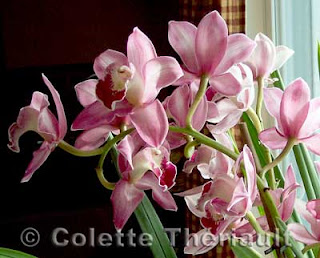Tuesday, February 24, 2009
Kaleideoscope Phal
Keiki hormone paste

This node was already swelled when I applied the paste so may end up producing more blooms instead of a keiki.

This node was totally undevelopped (flat) at the time of application. At 3 weeks post application, one can already see the swelling or growth of tissue that may form a keiki .
This is my second attempt at producing keikis on phalaenopsis using Keikigrow hormone paste. When the hormone is applied to the nodes on a phalaenopsis flowering stem, small plants called keikis are induced to grow. These keikis are exact replicas (or clones) of the mother plant.
Here the paste was applied at two different nodes, one which already had signs of growth before application (growth that would likely have resulted in more blooms). The second node had no active growth at the time of application. Once can already see the development of some tissue which will hopefully form a keiki.
Labels:
Keiki,
Keikigrow hormone paste,
Phalaenopsis
Keiki formation induced by crown rot

One year old keiki in bloom!

Doritaenopsis : keiki (baby plant) attached to mother plant (larger plant).

Mother plant showing crown rot.
Thought I'd share some pics of my doritaenopsis keiki that formed as the result of the mother plant succumbing to crown rot. The keiki flowered at about 1 year of age while still attached to the mother plant. I am hoping when I remove the keiki that a second one will from from the mother.
Friday, February 20, 2009
Orchid division

Well, I had the courage today to finally divide one of my prized orchids (actually, they all are for me). Last year's growth on my odontocidium had produced 2 new growths which were so high out of the pot that they needed repotting. In addition, I was concerned that one of the divisions was at risk of dying as the roots seemed to be drying out.
I was able to carefully remove the healthier growth furthest away from the mother bulb and replanted in a mixture of coarse orchid bark mix and New Zealand spagnum peat moss. The other bulb was left on the mother bulb.
I also removed 2 old backbulbs which don't seem to have any healthy "eyes" left on it. Nevertheless I will give them a try at propagation just in case.
I was able to carefully remove the healthier growth furthest away from the mother bulb and replanted in a mixture of coarse orchid bark mix and New Zealand spagnum peat moss. The other bulb was left on the mother bulb.
I also removed 2 old backbulbs which don't seem to have any healthy "eyes" left on it. Nevertheless I will give them a try at propagation just in case.
Tuesday, February 10, 2009
Saturday, February 7, 2009
Friday, February 6, 2009
Doritaenopsis "Ever Spring Prince"

A brightly colored Doritaenopsis! My specimen plant succumbed to crown rot but managed to form a nice little keiki for me. The keiki, still attached to the mother plant, has put up this first spike at only 1 year of age.
Labels:
Doritaenopsis,
Doritis,
Ever Spring Prince,
Phalaenopsis
Peloric Phalaenopsis

This strange looking Phalaenopsis has sepals opening as they should but the petals do not completely open! I find it gives the flower a "daffolil" or "cattleya" appearance. What attracted me to this orchid was the beautiful soft pink and yellow tones as well as the unusual looking flower. The phenomenon is called peloria and it is the result of a mutation.
Labels:
closed petals,
mutation,
peloria,
peloric,
Phalaenopsis
Tuesday, February 3, 2009
Pinstripe Phalaenopsis
NOID Moth Orchid
White Phalaenopsis NOID
Sunday, February 1, 2009
NOID Moth Orchid
Yellow Phalaenopsis

The flowers of this yellow phal has a waxy texture. The blooms open a lime yellow color that progresses to bright yellow with tiny maroon flecks. Although this moth orchid is not fragrant, it compensates by producing many brightly colored flowers which it sports on sometimes up to three spikes per plant! This orchid is a cross of Phal "Taipei Gold Goldstar" x Phal "Goldberry Carmela".
Phalaenopsis "Paul Tatar" x
Phalaenopsis "Brother Mirage Brother"

The phalaenopsis (phals) or moth orchids as they are commonly called are one of the easiest orchids to bloom in the home. This one is a nice speckled magenta on white.
Labels:
brother mirage brother,
moth orchid,
Phalaenopsis
NOID oncidium
NOID but possibly Dialaelia "Snowflake"

Unfortunately, this orchid was purchased with a mislabeled tag and so is a no id. It has been suggested by fellow orchid experts that this orchid is a cross between laelia albida and diacrum bicornutum (now known as caularthron bicornutum).
This orchid forms a nice compact spindle shaped bulb with stiff curved strap-like leaves. The flowers open pure white and change to a salmon color at maturity. Slight fragrance is noticeable when the flowers are mature.
Labels:
diacrum,
Dialaelia snowflake,
hybrid,
laelia albida,
no id
Miltonidium hybrid


This awesome orchid is another of my miltonidium hybrids. It is so floriferous that I usually loose count of the flowers (from 50 - 100 per spike)! The flower spike measures over 1m tall and one plant can have 2 spikes in bloom at one time. To top it off, the flowers are immensly fragrant and easily fill a whole room. The cultivar is "Issaku Nagata".
Odontocidium hybrid


flower spike about 2ft tall
Label: (Odo. Durham Supreme x Odo. Crispen)novelty X Onc. Maculatum sp. "Green Selves".
Another of my beloved favorites, this rare (unnamed) cultivar I found by pure chance. I purchased as a seedling and so had no idea of the flowers until it bloomed. What a delightful surprise when this baby put out a spray of exotic looking blooms! Individial waxy flowers measure about 3 inches tall and are star shaped. It closely resembles Vuylstekeara which is an intergeneric hybrid resulting from a cross with Milt Ron’s Rippling Delight ‘Pacific Parfait’ x (Vuyl Mem Mary Kavanaugh x Oda John Hainsworth).
Labels:
intergeneric hybrid,
miltonium,
ondontoglossum,
vuylsterkeara
Brassia Spider Orchid
Dendrobium hybrid

Close up of flowers

Potted specimen in bloom
Dendrobium seed pod
Keikis growing on mother plant
Here is one of my very first orchids, a hardy dendrobium hybrid. This plant bloomed reliably for many, many years and the blooms were more and more numerous with each passing season. This dendrobium started flowering around Christmas and blooms lasted until early to late summer.
Here is one of my very first orchids, a hardy dendrobium hybrid. This plant bloomed reliably for many, many years and the blooms were more and more numerous with each passing season. This dendrobium started flowering around Christmas and blooms lasted until early to late summer.
Dendrobium orchids reproduce sexually (pollen and ovary) to produce seed pods and asexually by forming small plantlets growing on the mother plant. The plantlet is called a keiki (means "baby" in Hawaiian).
Labels:
dendrobium,
hybrid,
keki,
reproduction,
seed pod
Orchids currently blooming

Here is a close up of a popular miltonidium hybrid (cross between a miltonia and an oncidium) variety named "Pupukea Sunset". This hardy little plant blooms profusely on a compact plant and multiplies very easily. An extra bonus is the fact that the flowers are wonderfuly scented!
Labels:
compact orchid,
hybrid,
miltonia,
miltonidium,
oncicium,
pupukea sunset
Welcome to my world of orchids!!
I will be posting information and photographs of my orchid collection here so stay tuned!
Subscribe to:
Comments (Atom)

























